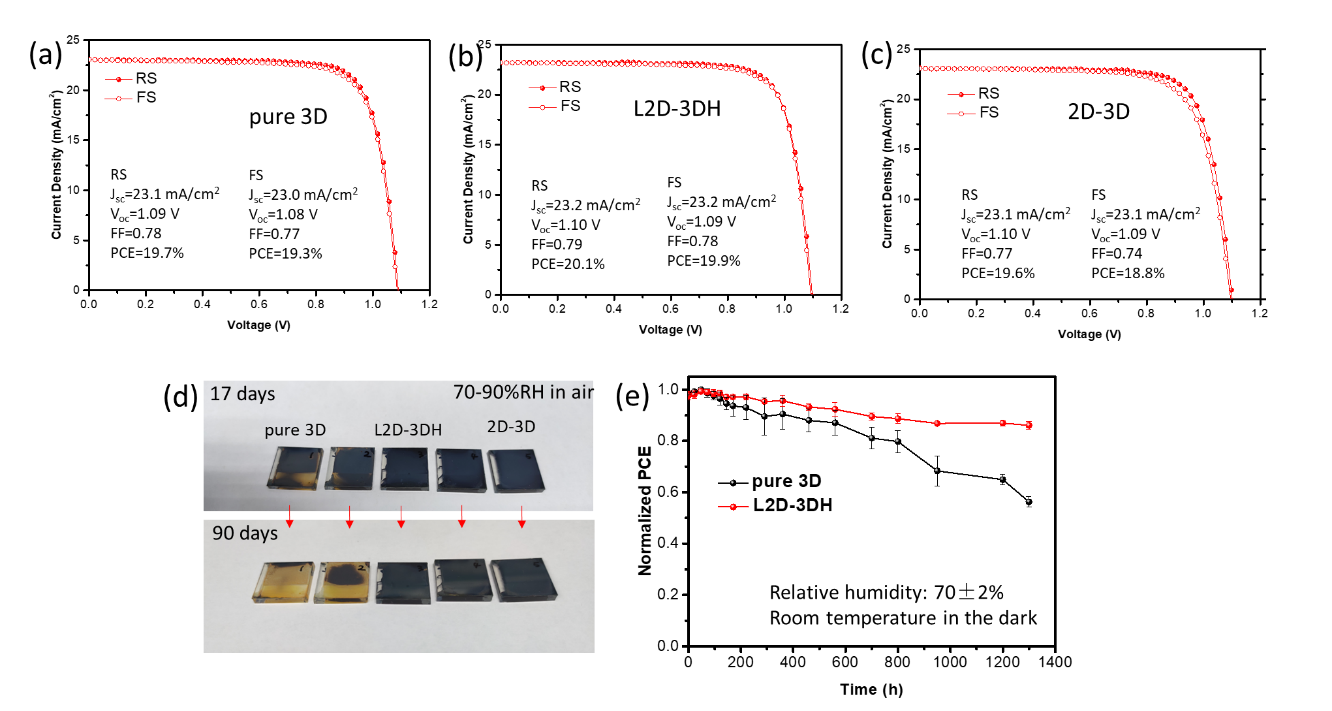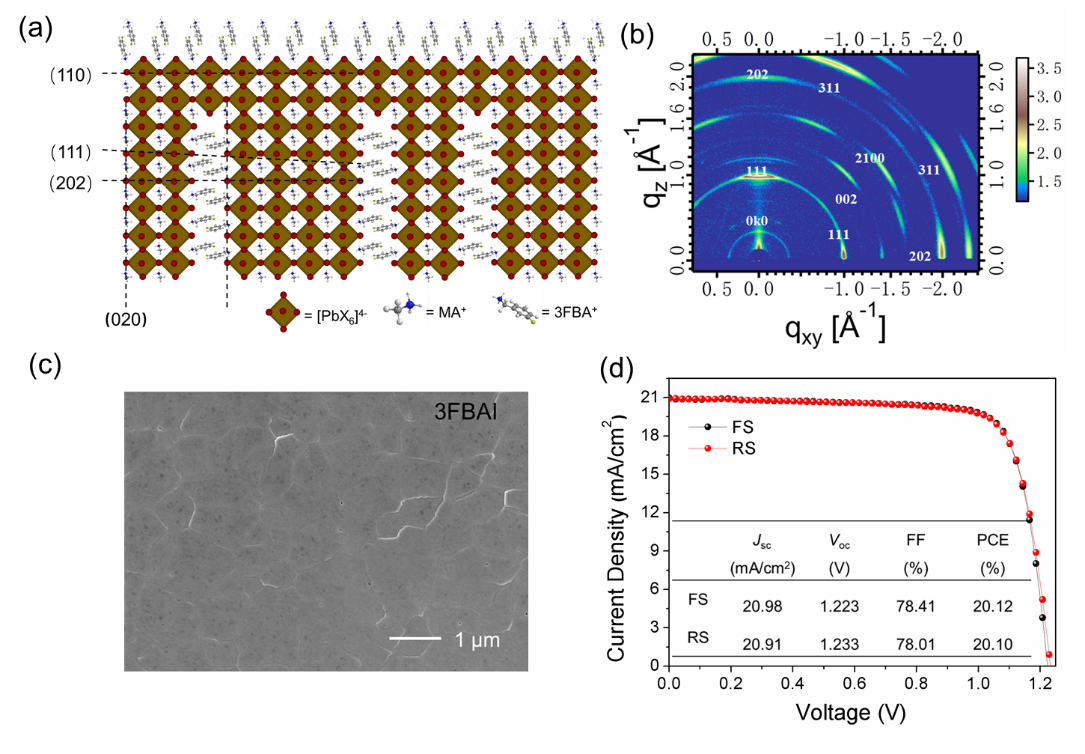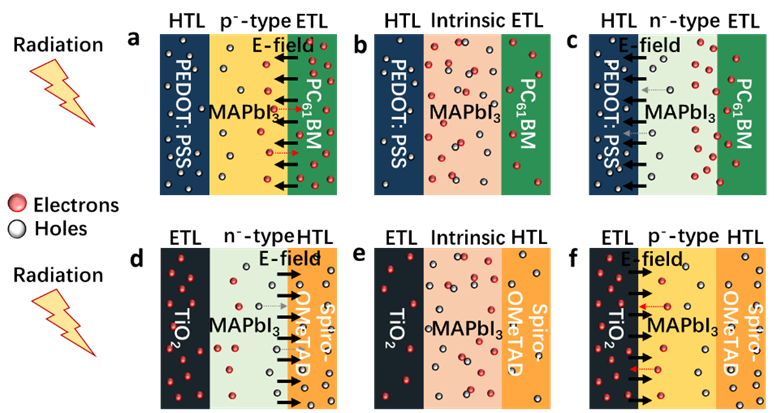Perovskite solar cell (PSC) based on organic-inorganic metal halide perovskite has shown tremendous progress in photovoltaic research. The power conversion efficiency (PCE) of PSC now reaches over 25%, comparable to that of monocrystalline silicon solar cells. With such high efficiency, PSC could be ready for commercialization upon considering its efficiency alone. Nevertheless, the unacceptably low device stability under operative conditions is still a major challenge for its market uptake.
Perovskites are decomposed easily under exposure to moisture, oxygen, heat and light, and therefore constructing a stable structure perovskite has become a technology bottleneck. Recently, 2D layered perovskites have exhibited much better stability than 3D perovskites, but the enhanced stability has been at the cost of efficiency. Hence, how to improve stability without sacrificing efficiency is another challenge in this research field.
In this regard, a research team led by Professor Aung Ko Ko Kyaw from the Department of Electrical and Electronic Engineering at the Southern University of Science and Technology (SUSTech) has developed a new structure of layered perovskite to improve the stability and efficiency simultaneously.
Their research, entitled “Efficient and stable mesoscopic perovskite solar cell in high humidity by localized Dion-Jacobson 2D-3D heterostructures,” was published in Nano Energy, a high-impact factor journal considered one of the most prestigious journals in energy research.

Analyzing the efficiency of L2D-3DH structure
In their innovative approach, 2D-3D composites were constructed by a Localized 2D-3D Heterojunction (L2D-3DH) structure. Dion-Jacobson (DJ) phased 2D perovskite was selectively grown on the localized area of 3D perovskite, especially at the grain boundaries. Compared to conventional 2D-3D composites, such as capping and interspersing structures, their L2D-3DH structure has several advantages.
In a capping structure, the full coverage of horizontally oriented 2D perovskite on 3D perovskite inhibits the charge transport thanks to the low mobility of organic spacer cations. In an interspersing structure, the charge carriers can be transported through an inorganic slab of vertically-oriented 2D perovskite, but controlling vertical orientation is complicated. In contrast, crystal orientation is not critical in the L2D-3DH structure because the charge carriers can be effectively transported through an exposed area of 3D due to the partial coverage of the 2D plate. Hence, the L2D-3DH structure does not hinder the charge transport while eliminating the complicated process for vertical crystal orientation.

Figure 1. Crystal orientation and charge transport in various structures of 2D-3D composite
Interestingly, partial coverage of 2D perovskite can effectively prevent moisture penetration owing to the stable DJ phase perovskite. The perovskite films fabricated in the L2D-3DH structure were still intact even after storing for 90 days in high humidity of 70%. But pure 3D perovskite film started to degrade after 17 days.
Moreover, the L2D-3DH structure did not affect the device efficiency, but the capping structure decreased its efficiency due to the inefficient charge transport. In fact, the L2D-3DH structure improved the device efficiency because DJ 2D plates reduced the trap density and suppressed non-radiative recombination through passivation. Consequently, the PSC with L2D-3DH structure achieved a PCE of 20.1% and retained 86% of its initial efficiency after 1300 h in high humidity of 70%.

Figure 2. (a-c) J–V characteristic of devices based on pure 3D, L2D-3DH and 2D-3D. (d-e) Stability test of perovskite films and device in the humidity of 70%
Dr. Wenhui Li from Prof. Kyaw’s team at SUSTech is the first author of this paper. Prof. Kyaw is the sole corresponding author. Xiaoyu Gu and Chengwei Shan, Ph.D. students at SUSTech, also made a significant contribution to the study.
Acquiring an efficient and stable PSC
Before this study, Prof. Kyaw’s team collaborated with Prof. Gongqing Li from Nanjing Tech University in attempting to obtain a highly efficient and stable PSC. They aimed to do this by constructing quasi-2D perovskite using 3-fluoro-benzyl ammonium iodide (3FBAI) as a bulky cation.
This study, entitled “High-performance quasi-2D perovskite solar cells with power conversion efficiency over 20% fabricated in humidity-controlled ambient air,” was published in Chemical Engineering Journal.
With 3FBAI cation, quasi-2D perovskite films exhibit vertical orientation with fewer grain boundaries and almost no pinhole. Furthermore, the fabrication of quasi-2D perovskite was carried out in humidity-controlled ambient air (RH 20% for spin coating process and RH 70-90% for annealing process). This demonstrated much more advantage compared with other quasi-2D perovskites as the literature. The preparation of low-dimensional perovskites usually requires a glove box filled with an inert gas.
This work shed light on the development of high-quality quasi-2D perovskite film fabricated in humidity-controlled ambient air by a simple and easy process. It is appealing for the future industrialization of PSCs with a low cost.

Figure 3. (a) Illustration of the crystal structure of quasi-2D perovskite (b) GIWAXS pattern of the quasi-2D perovskite (c) SEM image of pinhole-free quasi-2D film (d) J-V characteristic of quasi-2D based PSC
Lai Xue from Prof Kyaw’s team at SUSTech is the first author of this paper. Prof. Kyaw is the corresponding author. Prof. Gongqiang Li from Nanjing Tech University and Prof. Feng He from the Department of Chemistry at SUSTech are the paper’s co-corresponding authors.
In addition to the new perovskite structure, Prof. Kyaw’s team also studied unintentional doping in perovskite, which originates from variation in process conditions and its influence on the device performance. They did this in collaboration with a research team led by Prof Xiao Wei Sun and Prof Kai Wang.
Their study, entitled “Universal Strategy for Improving Perovskite Photodiode Performance: Interfacial Built-In Electric Field Manipulated by Unintentional Doping,” was published in Advanced Science. It was also selected as the back cover of this journal’s edition.
The researchers discovered that annealing time and temperature during the crystallization process caused unintentional doping in perovskite. As a result, this changes the built-in electric field at the interfaces between the perovskite and charge-transporting layers due to the Fermi level shift. According to their finding, the strong electric field at the interface far away from the light incident side is essential for efficient charge extraction to improve the device performance. This phenomenon is true for both regular (n-i-p) structure and inverted (p-i-n) structure devices and can be applied as a universal strategy to improve all device structures’ performance.
Assistant Professor Dan Wu, Dr. Wenhui Li, and Research Assistant Haochen Liu are the first authors of this paper. Prof Kyaw, Assistant Prof. Dan Wu, and Prof. Kai Wang are the corresponding authors.

Figure 4. Schematic diagram of electric field enhanced charge extraction at the interfaces in (a-c) inverted structure and (d-f) regular structure
These studies were supported by the Guangdong Basic and Applied Basic Research Foundation, Guangdong University Key Laboratory for Advanced Quantum Dot Displays and Lighting, and the Department of Education of Guangdong Province University Innovation Foundation.
Paper links:
Nano Energy: https://doi.org/10.1016/j.nanoen.2021.106666
Chemical Engineering Journal: https://doi.org/10.1016/j.cej.2021.130949
Advanced Science: https://doi.org/10.1002/advs.202101729
To read all stories about SUSTech science, subscribe to the monthly SUSTech Newsletter.
Proofread ByAdrian Cremin, Yingying XIA
Photo By